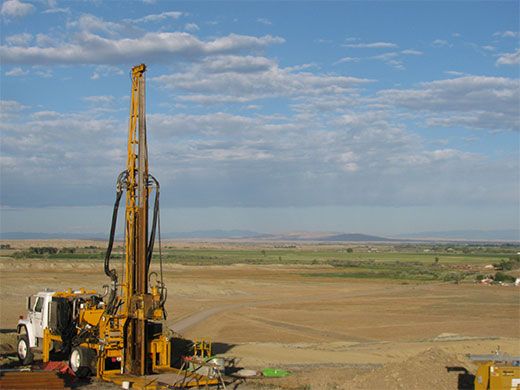Wyoming Paleontology Dispatch #6: Bringing Up a Core
One thing everyone has told us is that you never know what you will find underground
/https://tf-cmsv2-smithsonianmag-media.s3.amazonaws.com/filer/Wyoming-Dispatch-6-coring-rig-631.jpg)
The next phase of the summer’s work has begun: the Bighorn Basin Coring Project. The project is funded by a National Science Foundation grant to Will Clyde at the University of New Hampshire, Phil Gingerich at University of Michigan and me, but it involves many colleagues at universities in the United States and abroad. Our goal is to produce records of environmental and ecological changes through the PETM and also from another period of global warming that occurred about two million years later, a sort of little brother to the PETM that is called ELMO.
Even after many decades of work on outcrops in the Bighorn Basin, we have good reason to think we will learn a lot more from coring. The cores, taken at two sites (called Basin Substation and Polecat Bench), will give us our first glimpse of unweathered rocks deposited during the PETM and ELMO. Our preliminary data suggest that these fresh, relatively pristine samples should contain “molecular fossils”—chemicals that were created by living plants 56 million years ago—that have been destroyed in rocks near the surface. In addition to preserving molecular fossils, each core is also a simple, vertically stacked sequence of samples many hundreds of feet thick, representing hundreds of thousands of years. In contrast, surface outcrops usually expose a shorter stack of rock layers and therefore a shorter time interval, and we have to knit together records from many different outcrops in different places to construct a longer history. Each link from one outcrop to another carries a little uncertainty, so having long vertical sections of rock from the cores will give us greater confidence in the sequence of events through time, as well as the ability to sample at close intervals for a more detailed chronology of events.
Allie, Elizabeth, Brady and I arrive in Greybull, Wyoming, on the afternoon of July 13, where we meet up with the other members of the science team: Guy Harrington, a specialist on fossil pollen and spores from the University of Birmingham in the United Kingdom; Johan Weijers, a biogeochemist from the University of Utrecht in the Netherlands; and Aaron Wood, a vertebrate paleontologist from the South Dakota School of Mines. We also meet with Doug Schnurrenberger and Anders Noren, experienced scientific corers from the University of New Hampshire and the National Lacustrine Core Facility. Doug and Anders are translators and advisers—their job is to help the science team understand what the drillers can and can’t do, and to help the drillers understand what the scientists want to accomplish. Together we head west to the Basin Substation site, where we find the drillers from the Ruen Company: Ben Goody and his assistant Cody Halliday. They are busy setting up the truck-mounted coring rig, unloading drilling pipe and showing the bulldozer operator where to level the site. Just to add to the excitement, the radio announces a tornado warning for the area around the drill site, though when the black clouds and rain streaks arrive they blow harmlessly over the tower of the rig.
Even the most rational person might wonder if this is a good or bad omen. We are about to spend hundreds of thousands of dollars on an activity we have never undertaken before, and the one thing that everyone has told us is that you never know what you will find underground. Drilling is as uncertain as the weather.
The coring machinery is complex, but it can be boiled down to a few elements. The drill bit is a set of teeth around the leading edge of a hollow pipe. As the drill pipe rotates, the bit cuts through the rock, and a column of rock about two and a half inches in diameter rises into the center of a sleeve that fits inside the end of the pipe. The drilling is done roughly five feet at a time. At the end of a drilling run, Ben drops the “overshot” down the inside of the pipe. When it reaches the bottom it latches on to an assembly that includes the sleeve as well as a “core catcher” at its bottom that holds fast to the base of the column of rock inside the sleeve. Activating the cable winch, he then draws the overshot, the sleeve, the core catcher and the column of rock back to the surface through the drill pipe. He then disconnects the sleeve containing the core section, and Cody pulls it onto a sawhorse-like contraption, unscrews the core catcher and extracts the core in its liner from inside the sleeve. If all has gone well, Cody then hands one of the science crew a section of clear plastic liner containing a cylinder of solid rock five feet long.
After discussing the exact placement of the coring rig, the science crew heads back to Greybull for an early dinner and bed. We will start coring tomorrow morning at 7, and we day-shift people will face 12 hours in the hot sun. The night shift has decided to come with us tomorrow morning to see the beginning of coring, then they will return to the motel for a nap before they return to the site at 7 p.m. and work until the next morning. Although we will be working on the same coring operation, day shift and night shift will hardly see each other for the next several days except for 30 minutes at each shift change. It is going to be an intense experience.
Scott Wing is a research scientist and curator in the Smithsonian Institution’s Department of Paleobiology.
/https://tf-cmsv2-smithsonianmag-media.s3.amazonaws.com/accounts/headshot/SLW_photo_-James_Kegley_for_Smithsonian.jpg)

/https://tf-cmsv2-smithsonianmag-media.s3.amazonaws.com/accounts/headshot/SLW_photo_-James_Kegley_for_Smithsonian.jpg)